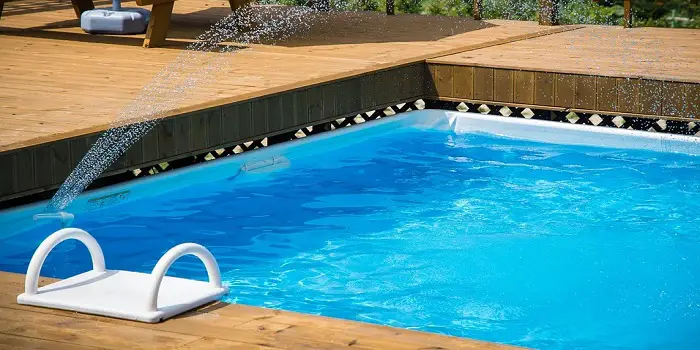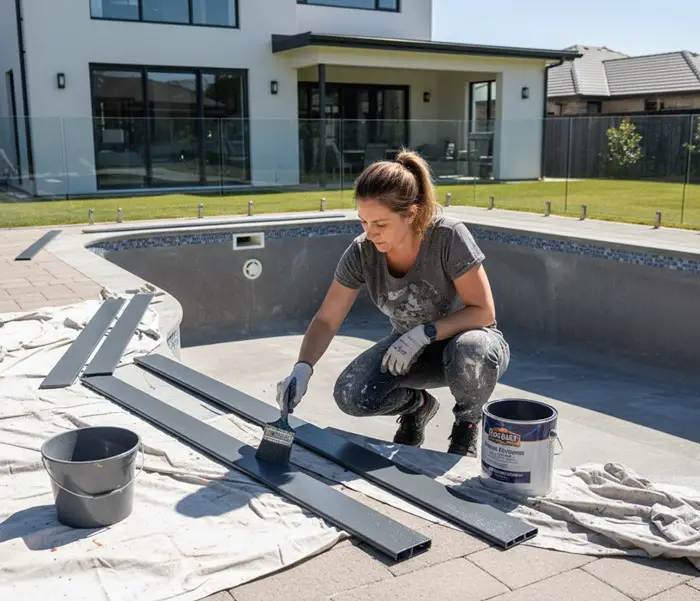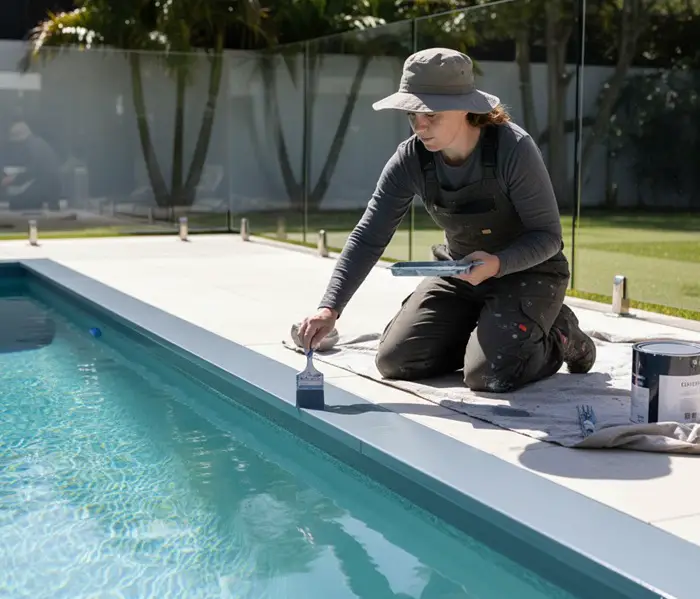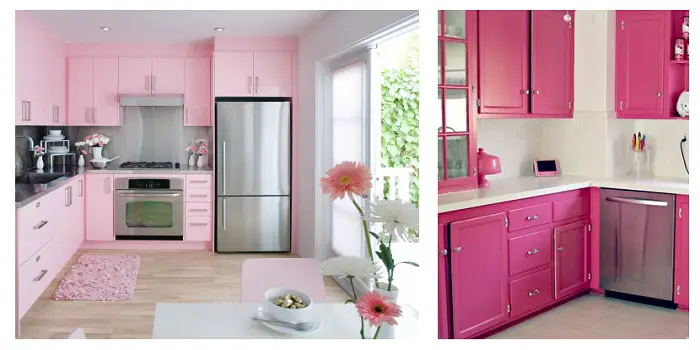
The pool coping is the horizontal capstone that sits at the top edge of the pool.
Sometimes also called the top rail (which denotes its location), it is designed attractively with an outward slant to direct the splash-outs away from your pool into the deck drains.
The coping can be made from different materials such as aluminum, stone, concrete, vinyl resin, and stamped steel that has been electrostatically painted.
They are also available in several different styles, of which PVC bullnose is arguably the most popular for the vinyl lining.
Most aluminum pool coping is not painted when used in above-ground pools. However, it can be painted if you use the right type of paint and application procedure.
So, let’s have a look at how you can do that…
What's Here in the Article:
How to Paint Aluminum Pool Coping?
While there is considerable information about how to paint a pool along with the pool deck, coping is another matter.
This is because pool edge coping is generally made from materials other than concrete or vinyl liner.
So, before you begin, you will need to note the type of material used to make the coping. For pool copings made of aluminum finish, you may use the following process to ensure that the paint sticks to the aluminum correctly.
Step 1. Clean the metal pool coping
Rule number one: paint sticks only as well as your prep work.
If your pool is drained, great—it makes things easier. If not, tread carefully to keep solvents and debris out of the water (your filter system will thank you).
Start by pressure-washing the coping to blast away dirt, oxidation, and pool chemicals. Then, switch to a scouring pad or textured sponge for the stubborn spots.
Next, wipe down the surface using acetone, xylene, or mineral spirits—these solvents cut through old paint, oils, and oxidation.
If some paint refuses to budge, use 320–400 grit sandpaper or a fine sanding block to remove the last layer. The goal is a clean, slightly matte surface—no gloss, no grime.
Pro tip: Don’t skip this part. Aluminum naturally forms an oxide layer that can repel paint if not cleaned properly.
Step 2. Sand the aluminum pool edge
Even freshly cleaned aluminum can be too smooth for coatings to bite into. To ensure that the paint sticks to the surface of the aluminum, you will need to sand and make it rough.
Use 300–400 grit sandpaper (or a scouring pad) and lightly sand the entire surface until it feels slightly rough to the touch. You’re not removing material—just texturing it.
If the existing paint is still intact and well-bonded (no peeling, no bubbling), you can simply scuff it and paint over it. But if you see flaking or chalking, strip it all down before repainting.
Step 3. Protect the areas with painter’s tape
Tape off tile lines, decking edges, and expansion joints so the new paint only goes where it’s supposed to. It’s a small step that saves hours of cleanup later.
If you’re spraying, mask even more generously. Overspray loves to travel—especially near water.
Step 4. Prime the pool coping trim
Aluminum demands a special type of primer—self-etching or epoxy-based primers are ideal.
These primers chemically bond with the aluminum surface, preventing corrosion and ensuring the topcoat doesn’t peel off in a few months.
You can apply primer using a HVLP spray gun, aerosol can, or foam roller for smaller sections.
Two thin coats are better than one heavy coat. Allow proper curing time between coats (usually 30–60 minutes, depending on the product and temperature).
Step 5. Paint your aluminum coping system
For aluminum pool coping, you may choose a high-quality aluminum enamel paint, acrylic latex metal paints, or epoxy-based metal paint.
These are designed to handle poolside abuse like sun, splash, and chlorine. Also, these paints are all UV-resistant and water-safe once cured.
You can spray for a smoother finish or roll it on using a foam roller for better control.
If any overspray lands in the pool, just float a few sheets of newspaper—they’ll absorb it before it spreads. For splatters on tiles or decking, a quick wipe with a scouring pad usually does the trick.
Pro tip: Let the paint cure for at least 48 hours before filling or heavy water contact. Full hardness may take up to a week.

Choosing the Best Paint for Aluminum Pool Coping
Painting aluminum pool coping isn’t just about looks — it’s about protecting the metal from oxidation, UV rays, and constant exposure to pool chemicals.
The wrong paint will peel or bubble within months, so here’s how to choose the right one that actually lasts.
1. Choose Paint Made for Aluminum and Outdoor Use
Aluminum is non-ferrous, which means regular paints won’t grip well. Look for paints labeled for use on aluminum or non-ferrous metals, specifically designed for exterior or marine environments.
- These paints are formulated to bond tightly and resist flaking.
- Common options include aluminum enamel paints, urethane coatings, or acrylic latex metal paints rated for outdoor use.
Top picks:
- Rust-Oleum Professional Aluminum Primer + Enamel Topcoat
- Krylon Fusion All-In-One for Metal
- POR-15 Top Coat (with Etching Primer)
2. Look for Corrosion and Chemical Resistance Paint Coatings
Pool coping takes constant abuse from water, chlorine, salt, and sun.
Choose a paint that resists oxidation, rust, and chemical attack — ideally one marketed for marine, pool, or coastal applications.
Great options:
- Rust-Oleum Marine Coatings Topside Paint – designed for boats, so it’s tough around water.
- TotalBoat Aluminum Boat Paint – sticks well to bare or primed aluminum and stands up to UV and moisture.
3. Avoid Regular Pool Paints and Pick a Finish That Balances Beauty and Safety
Regular epoxy paints and chlorinated rubber coatings are designed for concrete or fiberglass pool interiors, not metal.
They often don’t adhere to aluminum and can blister when exposed to direct sunlight. Stick to metal-specific or marine-grade paints instead.
High-gloss finishes look great but can be slippery when wet. Around a pool, choose a satin or semi-gloss finish for a subtle sheen with better traction.
If you want extra safety, you can mix in a non-slip additive (like Rust-Oleum Anti-Skid Additive) for walkable coping areas.

Why Do You Need to Paint the Coping Edge Around a Pool?
If you own an inground pool, you’ve probably noticed that the coping — that trim-like edge between the pool shell and the deck — quietly does a lot of work.
It frames your pool, protects the structure, and adds that finishing touch between concrete, water, and tile.
In most traditional concrete pools, coping is made from precast concrete, brick, or natural stone.
These materials age gracefully, don’t oxidize, and can usually be revived with a good power wash or mild acid clean — no paintbrush required.
Still, if you want to update the color or hide stains, you can use a pool deck coating designed for porous stone or masonry surfaces.
Things change, however, when we move to vinyl-lined inground pools.
Their coping is often made from extruded aluminum or PVC plastic — both sleek and functional, but not as forgiving when it comes to long-term appearance.
PVC Coping (The Paint-Resistant One)
PVC coping, on the other hand, is the rebel of the bunch. It’s smooth, non-porous, and chemically resistant — great for durability, not so great for paint adhesion.
Even high-bond primers struggle to grip its surface for long. If you’re dealing with PVC coping, it’s usually better to clean it thoroughly or replace sections rather than paint over it.
What About Steel Bands or Brackets?
Some pool installations use steel bands or fastening strips under or around the coping to hold the liner and deck edge securely in place.
If exposed, these absolutely should be primed and painted with a rust-inhibiting metal coating, or they’ll corrode over time and cause structural headaches later.
Aluminum Coping — Durable but Not Invincible
Aluminum doesn’t rust like steel, but it does oxidize over time.
This creates a dull, chalky layer and can cause the factory coating to chip, fade, or peel, especially in sunny, chlorinated, or saltwater environments.
Painting it isn’t just about looks — it’s about sealing and protecting the metal from chemical corrosion and UV damage.
A properly primed and painted aluminum coping can last years longer and maintain that clean, uniform poolside finish.

Tips for Painting Swimming Pool Copings Made of Other Materials
Not all pool copings are created equal — and certainly not all of them should be treated the same when it comes to paint.
Whether you’re dealing with steel, brick, or plaster, each material demands a slightly different approach to ensure durability and prevent future headaches. Let’s break it down.
For Steel Coping or Strips — Rust Is the Real Enemy
If your pool setup includes steel coping or anchor strips, you’re on a five-year maintenance schedule (give or take).
Steel’s biggest flaw? It rusts — and when it does, it spreads like wildfire under coatings. That’s especially true if you own a saltwater pool, where salt acts like an accelerant for corrosion.
Before painting, drain the pool and remove the coping. It may sound like extra work, but it saves you from introducing rust particles or metal shavings into the water system.
Inspect the steel thoroughly. If you spot any rust, start with Naval Jelly — it’s a phosphoric acid-based rust remover that dissolves corrosion efficiently.
For stubborn areas, follow up with a wire wheel, abrasive flap disc, or hand grinder (carefully used outside the pool area). Avoid grinding near the water — the metal filings will be a nightmare to clean out later.
Once the surface is rust-free and smooth, clean it again and let it dry completely. Then apply a rust-inhibiting primer — zinc-rich or epoxy-based primers are excellent options.
Apply two thin coats for full protection, letting each coat cure completely. Finally, top it off with a durable enamel or polyurethane metal paint for a clean, sealed finish.
Pro tip: In coastal or salt-chlorinated pools, a clear epoxy sealer over the paint can add years of extra protection.
For Precast Plaster, Brick, or Stone Coping — Think Like a Mason
Coping made from precast plaster, natural stone, or brick doesn’t need paint for protection — but a fresh coat can give it a uniform, modern look or hide stains and discoloration.
In this case, the key is preparation, not primer.
Start by giving the stones a deep clean with a pressure washer. This removes dirt, calcium deposits, and loose material.
If your coping is stained or discolored, consider using a diluted muriatic acid wash or an acid-based stone cleaner to restore its brightness.
Mold and mildew? They’re common near damp pool edges. Kill them off with a chlorine wash (one part household bleach to ten parts water) before rinsing thoroughly.
If there’s any oily residue — suntan lotion, body oils, or grease — wash the surface with Tri-Sodium Phosphate (TSP).
It’s a heavy-duty degreaser that ensures your coating bonds evenly. Whatever cleaner you use, rinse thoroughly and allow several days of drying time before painting.
Once completely dry, tape off surrounding areas with painter’s tape and apply a pool deck coating or masonry sealer formulated for outdoor use.
These coatings are designed to handle heat, foot traffic, and chlorinated water — giving your coping a refreshed, slip-resistant finish.
Repairing vs. Replacing the Pool Coping — Which Makes More Sense?
When your pool’s coping starts to show its age — chips, cracks, faded color, or a few loose sections — the big question arises: should you repair it or rip it out and start over?
The answer depends on what’s wrong, what it’s made of, and how much time (and patience) you have to spare.
Let’s dive in.
When to Repair Pool Coping
If the damage is cosmetic or minor, repairs can save you a lot of time and money.
Small cracks, loose mortar joints, or light corrosion on aluminum coping can often be fixed without a full replacement.
Here’s when repair makes sense:
- Minor Cracks or Chips: Use a pool-grade epoxy filler or patching compound to fill in the gaps. Once cured and sanded, a coat of paint or sealant can make the area look brand-new.
- Faded or Flaking Paint (Aluminum): Strip the old coating, sand the surface, and repaint using a metal-specific primer and UV-resistant enamel.
- Loose Bricks or Stones: Reattach using a masonry adhesive or fresh mortar mix, making sure the joints are fully sealed to prevent water intrusion.
Repairs are ideal if less than 20–25% of the coping is damaged and the structure underneath (the bond beam or liner track) is still solid.
Pro tip: Routine cleaning and sealing every 2–3 years can prevent most of these small issues from turning into costly replacements.
When to Replace Pool Coping
If your coping looks like it’s been through a few too many summers, replacement might be the better call.
Structural issues, severe corrosion, or water leaks around the coping line are all red flags that patching won’t fix for long.
Here are signs it’s time to replace:
- Extensive Cracking or Loose Sections: When the damage affects multiple areas, it usually points to shifting concrete, pool settling, or failed bonding mortar.
- Rust or Corrosion on Aluminum or Steel: Once rust eats into the metal, repainting won’t save it. Replacement ensures long-term stability.
- Water Leakage or Pool Liner Separation: If water seeps under the coping or your vinyl liner is pulling away, that’s a structural issue, not just a surface one.
- Aesthetic Overhaul: Sometimes it’s not about damage — maybe you’re updating the pool deck or switching to a more modern coping profile, like travertine, bullnose pavers, or cantilever concrete.
Full replacement costs more upfront but can dramatically improve your pool’s durability, safety, and resale value — not to mention the aesthetics.
Final Thoughts
Painting aluminum pool coping isn’t just a weekend project — it’s a precision job that rewards patience and prep work.
The trick is understanding what you’re working with: aluminum is smooth, non-porous, and a bit stubborn when it comes to paint adhesion. But with the right approach, you can get a finish that’s as durable as it is good-looking.
Don’t rush the drying times, and be mindful of overspray near the water — a few floating newspapers or drop cloths can save you from messy cleanup later.
When done properly, a painted aluminum coping not only enhances the look of your pool but also extends its lifespan by protecting it from chlorine, sun exposure, and moisture.
Share the post "How Do You Paint Aluminum Coping Around a Pool?"

Douglas Becker (aka Painter Doug) has over twenty years of experience as a painter in Adkins, Texas. At present, he resides in Florida with his family.
From painting multi-storeyed houses, condos, and apartments to large commercial buildings and small offices, he had served various customers in areas not only in Adkins but also in Southwest Florida, Sarasota, Naples, and many more. To know more about him check here.




